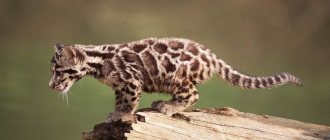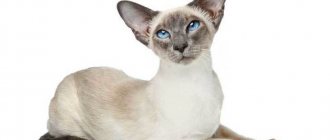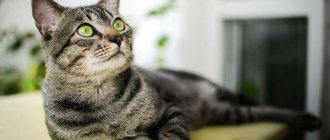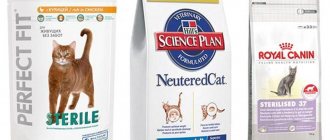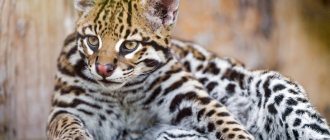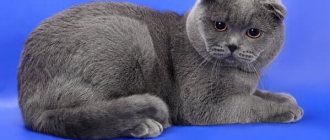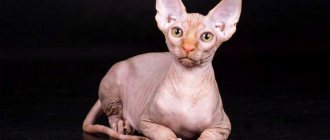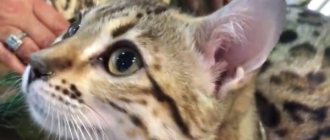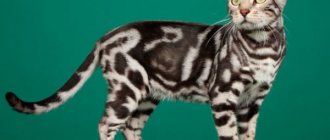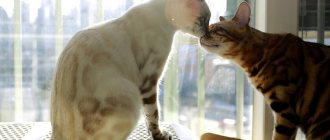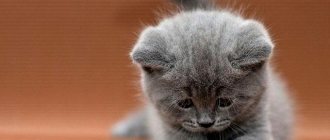How to distinguish a purebred Bengal cat
The idea of crossing a leopard cat and a domestic cat turned out to be so successful that it gained popularity all over the world. Few can remain indifferent to representatives of this breed, which is not surprising. Bengals have a natural grace and charm that can win the heart at first sight. How to distinguish a Bengal cat from an ordinary one? We will help you understand this difficult issue!
Photo and video
Photos of cats at different ages must be carefully considered before purchasing a kitten. This reduces the risk of running into deceivers.
Photo:
To learn more about the habits and characteristics of the Bengal cat, we suggest watching the video.
Video:
Video: Bengal cat (all about the breed)
Video: Bengal cat. Lecture about the breed
Video: 10 questions for the owner about the Bengal breed (Bengal cat)
Despite all the pros and cons, possible character difficulties, the Bengal cat remains a devoted friend and faithful ally for life. They are aristocratic, clean, smart, sociable and understand people very well.
Counterfeit of a popular brand
Over time, any fashion trend becomes counterfeit, aimed at obtaining money. But in the case of kittens, we are dealing with a living creature, and this is simply unacceptable. There are certain points to be aware of that can help you when choosing a purebred Bengal cat:
- Availability of a certificate;
- Correct color;
- Similarity to other kittens of the litter;
- Quite a high price.
When choosing a purebred Bengal kitten, you should pay attention to the place of purchase. Elite nurseries are concerned about their reputation, therefore, the risk of buying a fake is reduced to a minimum. Also, when buying a Bengal cat from a trusted place, you will definitely be given a certificate confirming the presence of the animal’s pedigree and its origin.
The correct color is of great importance. This is exactly why the breed gained its wild popularity. It is not difficult to distinguish a purebred kitten - its color will be bright and clear, the spots should look quite symmetrical, and those located along the vertical should be well defined.
Check twice, buy once
The price of a Bengal cat cannot be low. This is an axiom that allows you to be wary when you are offered to buy a kitten at a reduced price. There are two options here - either it’s a fake, or the kitten is sick. Walk past such advertisements and do not pay attention to them.
There are several kittens in a litter, and breeders usually offer to choose one of them. You should be wary if you are offered a certain animal, praising its beauty and character. There may be a situation of deception on the part of unscrupulous sellers, which may lead to you purchasing a counterfeit product.
Basically, the breed is important for people who dream of receiving awards and medals at various exhibitions. The organizers and judges of such events will quickly and easily distinguish a purebred Bengal cat from a mongrel one. It would be very unpleasant to find yourself in such a situation. Be careful, choose wisely, and then your kitten will turn into a beautiful, stately cat worthy of all awards.
Source
Bengals. Beware of “counterfeits” or “All that glitters is not gold”!
Despite its youth - just over half a century has passed since the very idea of creating this breed appeared - the Bengal breed is perhaps one of the most popular in the world today. The reason for this popular love lies, first of all, in the unusual color of these animals: there is hardly at least one person who will be indifferent to the unimaginably beautiful, sparkling pattern of the Bengals. This is true beauty, gifted to the Bengal by nature itself and carefully preserved by the best breeders of the breed.
But, like everything popular, the Bengal breed cannot avoid “fakes.” A fashionable gadget comes out and its “Asian twins” immediately appear; a top fashion designer releases a collection of clothes - and almost on the same day, “new items” from the catwalks fill the shelves of obscure stores... But if a substandard gadget, crooked stitching on a bag or a poor-quality print on fabric is immediately visible, then you can distinguish a real Bengal from a “fake” much more difficult. Unfortunately, there are people who buy mediocre representatives of the breed - to make it “simpler, cheaper.” And if such kittens are bought, as they say, “for love,” it’s not so bad; The real problem is if such an owner imagines himself as a “breeder” and begins to distribute the descendants of low-quality animals. Alas, this happens, and this can lead to erosion of breed characteristics and a general decrease in the quality of the Bengal breed. This absolutely cannot be allowed, so when choosing a kitten, remember: there are no real Bengals “for three pennies.” They simply do not exist, and this is an axiom.
So how can you distinguish real “Bengal gold” from what “just glitters”? Let's start from the very beginning. The Bengal breed was conceived and created to replicate the appearance of the wild Asian leopard cat, but with a “domestic” temperament. Jane Mill, who is considered the founder of the breed, took it up essentially out of compassion. While on a business trip in Bangkok, Jane, then with her maiden name Sugden, saw charming Felis Bengalensis, or ALC, kittens at a local market, similar in size to ordinary house cats, but “wearing” fur coats of such incredible beauty that Jane’s heart fluttered. Moreover, this species of animals native to Southeast Asia at that time was on the verge of complete extinction, and unscrupulous businessmen sold the babies in markets to visiting Europeans and Americans as living souvenirs. Trying to preserve this incredible beauty for people, Jane bought a lovely Asian leopard cat, named her Malaysia and crossed her with a black domestic cat at home in the USA.
However, due to objective circumstances, work on the creation of the Bengal breed was interrupted for 20 long years, and only in the early 80s of the last century was Jane Mill able to return to creating the cat of her dreams. And finally, in 1991, incredible gentle domestic cats of wild leopard color first appeared at the TICA exhibition. And they conquered everyone. Following Mrs. Mill, other American breeders became interested in breeding the breed and creating its unique appearance and temperament, devoting more than a decade to the result that Bengal fans see today. After all, a true Bengal is a unique breed from the nose to the tip of the tail!
Bright, impetuous, elegant, dexterous, strong, loving, intelligent, active... One can endlessly continue the series of admiring descriptions of Bengals. Once you see them, you will no longer be able to resist this breed. And it doesn’t matter whether you have only one Bengal at home or unnoticed))) you have become a breeder of this breed with a number of cats that will shock the average person. They enter human hearts immediately and confidently occupy every corner there: love for Bengal is love at first sight).
What are these cats like from the point of view of felinological science? A real Bengal is a large cat with a muscular build, with the gait and habits of a real hunter. Everything about Bengals shows that they belong to wild ancestors: this is the special structure of the head, the love of water, the extraordinary plasticity and grace characteristic only of wild cats, and the fantastically beautiful color.
It is the color that attracts many people to Bengals, and this is completely justified! Delicate to the touch, silky wool is extremely rich in color shades. Whether it is rosettes (like those of leopards or cheetahs), or a “special” marble pattern characteristic only of this breed, the tone of the coat is always distinguished by its extraordinary richness and characteristic radiance - glitter, and the pattern is clear, with a horizontal orientation. It should be emphasized that there are no two Bengals in the world with the same pattern: like human fingerprints, the pattern on the fur of each animal is strictly individual.
History of the Bengal breed
The Bengal cat is a hybrid of a wild Asian leopard cat with a domestic one. In the middle of the last century, leopard cats were almost completely destroyed by poachers. American Jean Mill bought a female wild animal kitten in 1961 and began breeding experiments on crossing with ordinary domestic cats in the hope of saving the Asian leopard breed from extinction. The first results were not entirely successful; the kittens appeared, although similar to their wild ancestors, but were aggressive, some died or were unable to reproduce. Mill continued her work, which lasted for 20 years, resulting in the emergence of the most beautiful breed of Bengal cat, which retained the wild color of its ancestors and the affectionate habits of domestic cats.
The breed was officially registered only in 1991. By that time, the best qualities of many exotic, short-haired breeds, Persian, Egyptian Mau and Burmese cats were mixed into it. In 1997, the breed first appeared in Russia, but its distribution began only in 2005. Today in our country there are a large number of nurseries of this breed, the cost of purebred kittens is from 35 thousand rubles, premium class exhibition specimens cost from 100 thousand rubles. (inf. 2021)
Origin, description, appearance
Bengal cat The Bengal cat resembles a small leopard, being a cross between domesticated and wild individuals.
The breed appeared thanks to a biologist from the USA named Jeanne Mill Sugden. The main direction of his research was the development of new breeds of cats. While visiting Bangkok, the scientist saw Asian wild cats that were in danger of extinction. Adults were exterminated for the sake of their unique skin; kittens became living souvenirs for tourists.
Genie bought a kitten and named it Malaysia. The pet remained a predator, but became a muse for the owner and inspired the scientist to create a new species.
Mill conducted a series of experiments on mating wild Bengal cats (natives from India) and domestic cats belonging to the Mau and Burmese breeds. The result of ten years of work are Bengals with the character of domestic animals and the external characteristics of wild animals.
Interesting! Today the Bengal cat is recognized by almost all breeder associations. The descendants of wild Indian cats settled in different countries of the world.
Animals of the Bengal breed are distinguished by a long muscular body and strong paws. The forelimbs are shorter than the hind limbs.
The cat's tail is rounded, covered with short hair, and its tip is darker. Adult cats reach a height of 37 cm, females - 33 cm. The average weight is about 5 kilograms.
Animals of the Bengal breed are distinguished by a long muscular body and strong paws.
Bengals have an oval forehead, an elongated muzzle, and rounded ears. The eyes are set wide apart and can be any color except bright blue. A turquoise iris is acceptable for Snow Bengals.
The animal's fur is smooth with a dense undercoat. Spots, stripes, and rosettes are acceptable in color. The color range varies from pearlescent to black-brown. A specific leopard print pattern is required.
Description of Bengal cats
Bengal cats are not very large in size, cats weigh up to 8 kg, the weight of cats barely reaches 6 kg. But at the same time they have the endurance, grace and dexterity of their ancestors, but the character is completely of a domestic pet, retaining only a small and best part of the traits of their wild ancestors.
The body is slightly elongated, has a strong skeleton and developed muscles. The paws are powerful, but proportional, the front ones are shorter than the hind ones, like those of wild ancestors. The paw pads are always black. The tail is of medium length, with a round black tip.
The head of Bengals is small and slightly wedge-shaped, slightly elongated in length. The neck is muscular, not very long. The ears are small, proportional, triangular in shape with rounded tips.
The muzzle is expressive, with clearly defined high cheekbones. The eyes are almond-shaped or oval, widely spaced. Eye color is varied, except for blue, which is acceptable only in snow Bengals with color point color.
The coat is short, silky, soft and smooth. The undercoat is dense. Bengal cats are not prone to heavy shedding. A feature of the breed is the so-called glitter - the shine of the fur, especially noticeable in bright light.
Color
Colors can be different, breed standards allow for several basic ones, the most common of which are leopard (Brown Tabby), silver, Snow Bengal, and charcoal.
The pattern of Bengal cats is acceptable in the form of spots, rosettes and stripes. Each spot or rosette must be clearly defined. The presence of spots in the tail area is encouraged, spots on the belly are required. The characteristic and obligatory dark tip of the tail .
Breed character and habits
There is a myth that Bengal cats have uncontrollable behavior. It is not true. Modern Bengals are adapted to living in apartments and private houses.
Activity is due to the innate instinct of the hunter. The best toys for Bengal cats are a ball, a laser, a wind-up mouse. Cats prefer active games and can endlessly chase “game”.
Be sure to read: Sphynxes are a hairless, but very smart and affectionate breed of hairless cats. Keeping Bengals with dogs or rabbits at the same time will not cause any trouble for the owner. And the cat will immediately begin hunting for rats, hamsters and parrots.
A small kitten should be picked up as often as possible and not left alone. Otherwise, the adult will resemble a wild animal.
Bengal cat personality
Bengals are very inquisitive, it is important for them to know everything that is happening around them, and it is also advisable to take part in it. They are incredibly active and mobile, love to play with the owner and all family members, as well as with other pets, get along well and are even friends with dogs.
They love heights, and having naturally high agility and jumping ability, they are sure to explore all the shelves, cabinets and other interesting places at heights. To satisfy their need for climbing, it is better to purchase a high play complex with shelves, ladders and posts. It is also better to place the house itself and the resting place at a height, so the cat will feel more comfortable and calm.
From their wild ancestors, Bengal cats also inherited an amazing love for water, especially flowing water. Not all, but many Bengals love to play for a long time with a trickle of water, swim and splash in a basin. They also love watching fish in the aquarium.
Bengal cats and cats are one of the most “talkative” cat breeds. Moreover, this is not a standard classic meow. Their intonations range from a quiet, sometimes whispered “meow” to an angry growl and almost the sound of a siren. These cats definitely need to “yelp” something when you approach, when you pick them up, when the cat itself passes by you. But she will never bore you with her meows, don't worry.
Bengals are renowned for their intelligence and are one of the smartest cat breeds. They perfectly understand human speech and intonation, easily remember the owner’s habits, down to the daily routine, down to the minute. They are quite easy to train and train. They can easily be trained to even fetch a candy wrapper or a toy, like a dog, and accustom them to a harness and leash. They remember their name almost the first time and quickly get accustomed to the tray and scratching post.
Despite their “feline” independence, Bengal cats are very attached to their owner and are able to subtly sense his mood. They clearly understand when it is necessary to approach and cuddle the owner, calming and lifting the mood, and when it is not worth approaching and it is better to wait out the “storm”. Separation from the owner is extremely difficult to bear, and they can start doing mischief out of spite. If you are often away from home for a long time, a Bengal cat will not suit you. The worst punishment for a Bengal is being ignored by the owner and lack of communication.
my beauty Eva
Differences between a Bengal kitten and a regular one
Spotted animals are very reminiscent of their direct relatives - real wild cats and leopards:
- A strong elongated body, powerful paws, a large head with ears rounded at the ends give them the appearance of real predators.
- The presence of a spotted color on a silver or golden background or a pronounced marbled pattern on a dark color with dense, soft and pleasant-to-touch fur makes it easy to distinguish Bengals from representatives of other breeds.
- A slender and strong figure completes the picture of a thoroughbred animal.
- The activity and playfulness of the animal, its friendly character. This makes it easy to raise a cat, instilling healthy habits in it from childhood and preventing uncontrolled behavior.
- Inquisitive character. The Bengal cat can learn new commands and is highly trainable.
The most popular for keeping at home are SBT Bengals, if they have all the characteristic features of the breed. The kittens are smart and playful, and their coat color resembles that of a leopard.
Important! Bengals are very smart, they can follow simple commands, give a paw and bring objects on command, and also learn to open cabinets and doors on their own.
How to choose the right Bengal kitten
The main thing when choosing a Bengal kitten is to take into account all factors, not only its purebred:
- Health. In first place among other signs. The susceptibility of purebred kittens to hereditary and infectious diseases will negate all efforts to educate and follow the rules of care.
- No developmental defects or birth injuries. Assess appearance, cleanliness of skin and eyes, activity and friendliness.
- Good pedigree. Before you adopt a kitten, get to know its parents: it is important that they are not overly aggressive. In Bengals, character is usually inherited: if the parents are calm and balanced enough, the offspring will be so too.
- The color must be clearly defined; it is also inherited from the parents.
Advice! Kittens are purchased at the age of 3 months, when they have already become quite independent. At this time, there is a change from the bright baby pattern to a faded, permanent one, which forms by 8–10 months.
It is better to purchase a Bengal kitten from trusted breeders; a high price will guarantee the quality of the breed and the absence of possible health defects. Make sure that the documents are in order and not tampered with.
Tips for choosing
The basic selection rules will be as follows:
- Selecting a generation of kittens. Basic Bengal cats of the early generation F1 are not recognized as pets - they are intended for breeding. SBTs are suitable - Bengals, purebred animals, all of whose relatives in four generations were Bengal cats.
- Decide which wool pattern you like best. The coat color can be rosette or marbled, and the main coat colors are brown and white, there are golden and cream variants, and the shimmering shine is called glitter.
- Selecting a breeder based on recommendations and reviews.
- Inspection of litter, background check of parents.
- Preferences in choosing gender - male or female.
- A thorough examination of the future pet.
Following the subtleties of choice will help you find the ideal pet and minimize the stressful period when adapting to new living conditions.
When all the requirements are met, follow your intuition and sympathy when choosing your future spotted pet. Compliance with the rules of maintenance and care will significantly extend its lifespan, and your Bengal pet will spend years with you filled with sincere friendliness and love.
1. Health. It is most important. Cats and kittens must have up-to-date VACCINATIONS. Don't hesitate to ask for your cat's veterinary passport. The cat owner must show you the cat's TESTS (coronavirus, viral leukemia, feline immunodeficiency virus, chlamydia (dangerous to humans) and a copy of the cat's tests. If there are no tests, then we can say that you are buying a “pig in a poke.” If the breeder is so careless to the health of his cat - the producer, then there are no guarantees that the kitten does not have worms, fleas, ear mites and other diseases. Not a single good cat in St. Petersburg will take a cat for mating without tests. If the cat was bred with a quality cat, tests should be . Of course, any breeder will claim that his cat is healthy, but whether to believe his words or not is your choice. Not a single kitten in the litter should have discharge from the eyes or nose. Look in the ears, under the tail, it should also be clean . If there is discharge, run away from such kittens! The kitten should be strong, large, feel the tail, it should be even. 2. Character, upbringing. Understanding the character of a kitten and its upbringing is difficult, but it is possible! You just need to be careful. Pay attention to the conditions in which the kittens and cat are kept. If the room has not been renovated for a long time, you can immediately turn around and leave; in such a place it is not possible to buy a high-quality Bengal. Or the kittens are locked in an isolated room (balcony, cage, toilet, kitchen), then there is a very high probability that the kitten is not accustomed to anything. Most likely, kittens pee “in the wrong place” and tear up walls and furniture. That's why they are not allowed everywhere, so as not to damage property. If kittens run freely around the apartment and jump on the scratching post in front of you, these are well-behaved kittens.
Care and maintenance
Bengals do not require any special care. The cat should be vaccinated regularly, given anti-parasitic tablets, monitor its diet, play and bathe as needed.
Hygiene
Important! To keep your pet healthy, you should pay attention to caring for the eyes, ears, claws and coat. To do this, remove dirt that has dried in the corners of your cat's eyes every day.
For the procedure, you can use wet baby wipes or a piece of cotton wool soaked in tea leaves or a special zoo lotion. The latter helps to cope with dark spots in the corners of the eyes of snowy and white Bengals.
Bengals do not require special care
Lotions for cats that relieve inflammation and remove ear mites are suitable for cleaning the ears. If the inside of the ear dries out, it is recommended to treat it with baby moisturizer. Brown or gray discharge is a reason to consult a veterinarian.
The Bengal does not need to specially trim or file its claws. The cat constantly wears down the claws on his front paws on a scratching post or rug, and chews on his hind paws.
The cat washes itself several times a day, combing out any loose hairs. This promotes the growth of new fur. Therefore, you should not bathe your pet unless absolutely necessary. But regular brushing improves skin regeneration, removes dirt and matted hairs, preventing the accumulation of hairballs in the animal’s stomach.
They bathe a Bengal cat if it gets dirty or to get rid of parasites. If the pet is sick, bathing is prohibited, as the procedure can provoke the progression of the disease.
The cat washes itself several times a day, combing out any loose hairs.
Diet and feeding
Bengals have a weak digestive system. Therefore, they need special nutrition. There are two types of food - natural or prepared (wet kibble or dry kibble).
Feeding your pet food from a human table is unacceptable. Spices, sweets, fatty and high-calorie foods are harmful to the cat.
Kittens up to 4 months of age are fed six times a day, from 4-6 months - four times, from 6 months to a year - 3 times. For adults, two meals a day is sufficient.
If there is any uneaten meat or prepared wet food left in the bowl, it should be thrown away. After eating a spoiled product, your pet may become poisoned. The exception is ready-made dry food. It can be left for a day.
Be sure to read:
Ocicat cat breed, description, character, price and advantages
Education and training
The Bengal cat is a bundle of energy; active games with the owner are important for him. A great option is hide and seek or chasing a rustling candy wrapper tied to a string.
Spending time together will increase mutual affection. Bengals are very sociable. They will be happy to “talk” to the owner.
When raising a kitten, it is worth teaching it the word “no”. To reinforce the prohibition, you can use a squirt gun or water gun.
Life expectancy and typical diseases
When raising a kitten, it is worth teaching it the word “no.” The maximum age that Bengals live to is 13-16 years. Life expectancy depends on genetics, nutrition and maintenance.
Cats of this breed are hardy and healthy. But they may have genetic diseases - cardiac pathologies, which can cause death. Bengal cats are also susceptible to gastrointestinal infections, poisoning and feline leukemia.
Castration and sterilization
Sterilization and castration is a humane choice for an owner who does not plan to engage in breeding. During the operation, the male's spermatic ducts are tightened or the testicles are removed.
For females, medical, radiation and surgical sterilization is offered. The optimal solution is surgical removal of the animal's uterus and ovaries.
Breeding
Difficulties in breeding are due to the slow change in the gene set. Breeding purebred Bengals requires mating a cat with a semi-feral appearance. But to confirm that the animal belongs to domestic cats, the baby must have four generations of domestic ancestors.
Mating and partner selection
It is prohibited to mix Bengal males with other breeds . The born offspring will lose its pedigree, and the appearance of the descendants will contain features of a different breed.
It is prohibited to mix Bengal males with other breeds.
How to choose a Bengal kitten
Before choosing a Bengal kitten, it is advisable to talk with current owners and visit breed exhibitions. You can also find a responsible breeder there.
To choose the right Bengal kitten, you need to pay attention to:
- for its compliance with the breed standard;
- behavior;
- health.
The mother cat should not be aggressive while examining the litter. She may show dissatisfaction, but under no circumstances try to scratch or bite.
Choosing the right generation
Bengals are a hybrid breed. Its progenitor is the wild Asian leopard cat (ALC). Therefore, before choosing a baby, you need to decide on his generation.
Feeding the Bengal
Bengal cats have a rather sensitive digestive system and may be prone to food allergies and intestinal inflammation. Therefore, the selection of diet and choice of food should be approached carefully; you should not experiment too much and change food frequently.
Dry and wet artificial food should be chosen from good, or better yet premium, brands. Cheap food is strictly contraindicated for Bengals.
Adult cats should be fed twice a day. Although, with their mobility and activity, Bengal cats are not very susceptible to obesity, besides, they do not like to eat all the food at once, but will come up throughout the day, satisfying their appetite. There must be fresh drinking water available at all times.
Some breeders feed Bengals with natural food, but this takes a lot of time, and choosing and correctly balancing the diet is quite difficult. Even in nurseries, as a rule, they feed artificial premium food from well-known brands. There are even special foods for Bengal and other oriental breeds, especially selected and balanced.
But under no circumstances should cats be fed from the table, especially spicy, smoked, sweet and other similar foods. This will have a bad effect on any animal, and especially on a representative of the still young Bengal breed.
Characteristics of this breed
Bengals are difficult to breed, which is why the breed is rare and expensive. Bengals are the most talkative of all domestic cats.
Be sure to read:
The German Rex cat (German Rex) is a short-haired breed with curly hair.
They can not only purr and meow, but also make about 100 unique sounds. If an animal gets angry, it will growl. Only Bengals can do this.
Cats of this breed are not afraid of water, and many even like to swim. This is the kind of “love” that Bengal cats have from their wild relatives. They lived in Asia, where there were many lakes, rivers and other bodies of water.
Size and weight gain
Cats are much larger than cats. After reaching puberty, the male becomes twice the size of the female. With a height of 90-100 centimeters, the weight of the cat is 8-9 kilograms.
Cats gain up to 5 kilograms. Bengals have a long, muscular body and strong legs.
Shedding
Bengal cats are short-haired, so with the right diet they practically do not shed.
The glitter on the Bengal fur should be pronounced, the fur should look like mink fur
Active hair loss can be triggered by a deficiency of vitamins due to an unbalanced diet or sudden changes in hormone levels.
Allergy
Many breeders say that Bengal cats cannot cause allergies. However, in the saliva of any cat, regardless of breed, there is a specific protein, which provokes a histamine (allergic) reaction.
Why you can’t pick up a kitten early
It is not advisable to separate Bengal kittens from their mother before 3 months. It is better to choose a baby who is 3.5-4 months old.
There are several reasons for this:
Pets that are taken from their mother early often become distrustful. In this case, an adult cat does not have time to instill in them the correct model of behavior and teach them how to communicate with people.
Where to buy and how much does a kitten cost?
The price of Bengal kittens is high.
Bengal kitten
This is due to the expensive process of breeding animals. If a breeder offers to buy purebred kittens for less than 30,000 rubles, this indicates deception.
What to pay attention to
Catteries that breed Bengal cats must show potential buyers the kitten's parents. This helps to evaluate the character and appearance of the father and mother of the Bengal baby.
When choosing a kitten you need to pay attention to:
There should be no redness, inflammation or discharge.
Approximate cost of a kitten
Important! On average, a pet will cost 40,000-50,000 thousand rubles.
The responsible breeder signs the contract. If the animal is not purchased for breeding, the text of the contract includes a clause on mandatory castration. The final price depends on the titles of the parents, cattery category and exterior.
The table will help you evaluate the advantages and disadvantages of the breed:
| pros | Minuses |
| Exotic color resembling a leopard | High price |
| Sociability, mobility | Weak stomach |
| Get along with other pets | |
| Easy care |
Health and illness
Bengal cats have fairly good health, inherited from their wild ancestors. main weakness is digestion : various intestinal disorders and a weak stomach.
Recently, information has appeared about two new characteristic diseases of Bengals. This is flat chest syndrome in kittens, as well as hypertrophic cardiomyopathy , leading to heart failure, thromboembolism and even death of the animal.
Distal neuropathy is a nervous system disorder that causes weakness and occurs in adult animals. In most cases, this disease goes away on its own.
Hip dysplasia , leading to lameness, pain and discomfort for the animal.
Vision problems include progressive retinal atrophy and degenerative eye diseases that occur as the animal ages.
With all this, Bengal cats are long-lived and live on average about 15 years, and can live up to 20.
